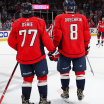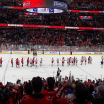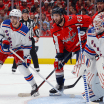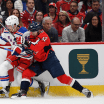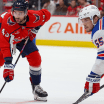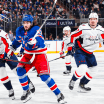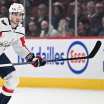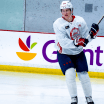#CapsLeafs Skate Shavings: Take Two
Caps seek swifter start, and both sides start to play the adjustment game as we move deeper into the series in Saturday's Game 2.

© Patrick McDermott/Getty Images
Toronto's mission all along is to get one of these first two games at Verizon Center to wrangle the home ice advantage in the series away from Washington. The Leafs came out strong in Game 1, scoring twice in the first 10 minutes of the game to take an early lead over Washington, the league's best regular season team.
Washington played 41 home games at Verizon Center during the regular season. The Caps surrendered more than one goal in the first period of exactly two of those 41 games, and both times, Washington scored the game's first goal before giving up any goals. In neither of those instances did the Caps surrender two goals in the game's first 10 minutes.
It's been a while since any team came into the Verizon Center and scored two early goals to take a two-goal lead over the Caps before the first frame was halfway over. The last time it happened was March 26, 2013 in a 3-2 loss to the New York Islanders during the lockout-abbreviated 2012-13 NHL season. The Caps played 189 regular season and playoff games at Verizon Center between that game and Thursday's Game 1 without ever giving up two unanswered goals in the first 10 minutes of a home game.
Washington got going in Game 1 once it began to impose its will on the Leafs, sometime toward the latter stages of the middle period. But the Caps also know they have to have a better start in Game 2.
"With our ability to play physical and play hard, to wear teams down when we put the puck in the right positions," says Caps right wing T.J. Oshie, "I feel like it backs teams off a little bit and gives us a little more space. Our game is very much designed to wear teams down and to strike at the end, but we have to have a better start than we did last game."
Adjust If You Must - As the two teams navigate their way deeper into the series, it becomes a game of adjustments, and adjusting to each other's adjustments. There are no bad teams in the playoffs, and there is no such thing as a perfect game in hockey. Without mistakes, goals would never be scored. So even the winning team is going to be making adjustments.
"What happens now after Game 1 is they're going to make some adjustments," says Caps coach Barry Trotz. "They came in with a game plan. We're going to make some adjustments; that's what we did [Friday] morning. They're going to do the same thing, and it's going to be a little bit of a tennis match here - we serve, we volley, that type of thing."
Teams will have meetings and video sessions in which they'll break down and discuss these adjustments, but adjustments on the fly - in the middle of the game, from shift to shift - will also occur, especially between linemates and defensive partners.
"We do," says Oshie, when asked about in-game adjustments. "We talk about a bunch of different things, based on [the opposition's] positioning. It's always different when [Alex Ovechkin] is out there, because he is a presence that people have to be worried about. The way people defend him affects how we're going to play the game in certain situations. Most of the time at five-on-five, it's somewhat the same. But definitely us three as a line, we talk on the bench and we try to make little adjustments that give us a better chance to score the next shift out."
All season long, the Caps talked about building their game and getting better. That sort of construction is ongoing for all players on both sides - men at work.
"I think the key for us and probably the key for them is just to worry about today," says Leafs coach Mike Babcock. "Everyone asks you all year, 'Is this an important game? Is that an important game?' The game you're playing is the most important game of the year. That makes it this one, but I think in this situation for sure.
"We feel we can play way better. But I'll bet you Trotzie is saying the same thing about his crew. So we've got to play better than we did [in Game 1] and then up more, because they're going to play better too. All you had to do was watch the [Stanley Cup playoff] games last night if you were sitting around or whatever you were doing. The intensity from Game 1 to Game 2 was different. So now you've got to up the ante. But now you've got to enjoy that, love it, love the fact that there is no room, but you're still going to get the job done."
Neither coach is going to discuss any of those adjustments or what they entail, but if you read between the lines of some player quotes, you can sometimes get an idea of what a team might be looking to improve upon.
"Just play more physical, play a little harder," says Oshie. "I think we turned away from checks. They do a pretty good job of trying to interfere with us, trying to slow us down. But we can do a little bit better job working through that and getting some more body contact.
"We did a pretty good job. At times, I thought we got the puck deep and worked them and limited their time and space. We could probably be better at getting more contact so they're not able to get up in the rushes. They've got some pretty good skaters up there that can make some things happen going the other way. We've got to get some bumps on them and [make sure they] stay down on the defensive side."
Shooting Shatty -The Capitals finished Thursday's Game 1 with 44 shots on net to 37 for the Maple Leafs. But a deeper dive into those numbers reveals some interesting information.
Toronto got 30 of its 37 shots from its forwards, and 70 percent (30 of 43) of the shot attempts from the Maple Leafs' forwards were on goal. Leafs blueliners got only seven of 19 shot attempts on goal, just 36.8 percent of the total.
With Washington, it was the other way around. Caps forwards managed 22 shots on net, getting 53.7 percent (22 of 41) of their attempts on goal. Meanwhile, Washington blueliners - led by nine shots from Kevin Shattenkirk - contributed 22 shots, and got two-thirds (22 of 33) of all their attempts on goal. Shattenkirk got nine of 10 attempts on goal in the series opener, and he arguably had more great looks at the net than any player on either side.
It seems as though there may have been more time and space with which to pull the trigger high in the Toronto zone in Game 1. When a team's forwards are aware of that, some low-to-high plays might be available, and could lead to some prime scoring chances, and, in a perfect world, a goal or two.
"I think the forwards just see it," says Shattenkirk. "Our group of forwards, the reason we were finding it, is because they were doing a tremendous job at the cycle game. A lot of tight turns in the corners were making it tough on their defensemen. It was drawing their wingers down, and really opening up the middle of the zone, where I found a couple of lanes down to the net.
"Our forwards just seem to make really poised plays, hang onto the puck when they had to and grind it out. And then when it was time to turn out of those scrums, the [defensemen] were finding the right lanes, and our forwards know that's probably going to be the first option when they come out of the corners."
Speaking of adjustments from one game to another, that's one the Leafs might be expected to make. Each of Washington's first two goals in Game 1 - the first of which came on a Caps power play - originated with a point shot from a defenseman who had crept down well below the Toronto line.
"I'm not going to be getting four or five of those a game anymore," sighs Shattenkirk. "But those chances will be there in a game, I think. They're probably going to tighten up a little bit, and get back to the middle of the ice a little more. But that leaves our forwards some time and space on the outside to create, and if they take us away, then they have to find the other lanes."
In The Nets -Caps goalie Braden Holtby stopped 35 of 37 shots he faced in Game 1, and he shut the door tightly on the Leafs after the midway point of the first period. Holtby has now permitted two or fewer goals against in 19 of his last 25 postseason starts. In six previous Game 2 outings during his Stanley Cup playoff career, Holtby is 4-2 with a shutout, a 1.40 GAA and a .957 save pct.
Frederik Andersen stopped 41 of the 44 shots he faced in Thursday's Game 1. While Andersen made some excellent saves in the third period while Washington was buzzing for the go-ahead goal in what was a 2-2 game at that point, he's probably not happy with the second and third goals he permitted in that contest.
Prior to Thursday, Andersen had gone five straight playoff games without surrendering as many as three goals in a contest. Since dropping four straight starts - three of them in overtime - in February, Andersen has not tasted defeat in consecutive starts since, a span of 15 appearances.
All Lined Up -Here is how we expect the Capitals and the Maple Leafs to look when they take the ice for Game 2 of their first-round Stanley Cup playoff series on Saturday night at Verizon Center:
WASHINGTONForwards
8-Ovechkin, 19-Backstrom, 77-Oshie
90-Johansson, 92-Juznetsov, 14-Williams
10-Connolly, 20-Eller, 65-Burakovsky
26-Winnik, 83-Beagle, 43-Wilson
Defensemen
27-Alzner, 74-Carlson
9-Orlov, 2-Niskanen
44-Orpik, 22-Shattenkirk
Goaltenders
70-Holtby
31-Grubauer
Injuries
None
Scratches
4-Chorney
28-Carey
88-Schmidt
TORONTOForwards
11-Hyman, 34-Matthews, 29-Nylander
47-Komarov, 43-Kadri, 12-Brown
25-van Riemsdyk, 42-Bozak, 16-Marner
15-Martin, 24-Boyle, 28-Kapanen
Defensemen
51-Gardiner, 46-Polak
44-Rielly, 2-Hunwick
52-Marincin, 8-Carrick
Goaltenders
31-Andersen
35-McElhinney
Injuries
12-Robidas (knee)
19-Lupul (sports hernia surgery)
22-Zaitsev (upper body)
23-Fehr (upper body)
26-Soshnikov (undisclosed)
32-Leivo (undisclosed)
Scratches
3-Marchenko
18-Smith



